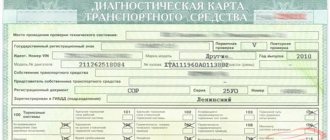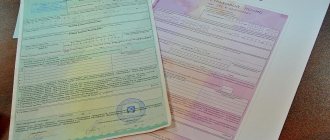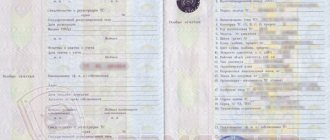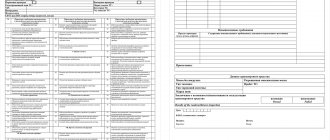Car inspection frequency
How often do you need to undergo a technical inspection and what does the procedure look like for a new car? The decisive parameter is the type of vehicle. Currently the following rules are established:
- Category B vehicles, motorized vehicles, trailers and semi-trailers must be subject to technical inspection 3, 5 and 7 years after the year of manufacture. After the specified period - annually.
- Once a year, C-category cars, cars used for driving lessons, and vehicles with special signals are inspected.
- Every six months, owners of taxis, vehicles for transporting people, buses and cars transporting dangerous goods will have to undergo a technical inspection.
If, for example, a B-category car produced in 2021 was purchased at a dealership in 2021, then there is no need to undergo technical inspection. What does the diagnostic chart look like in this case? In such a situation, it simply is not issued.
If the car is already 3 years old from the date of manufacture, then it is necessary to undergo a technical inspection, because without it you cannot issue an insurance policy.
Validity
The validity period of the card depends on the class and age of the car. As mentioned above, “young” cars do not necessarily need to undergo technical inspection. If, of course, you forget about the mandatory registration of compulsory motor liability insurance. For cars under 7 years old, maintenance documents are usually valid for up to two years. Whereas for older cars, the diagnostic card expires in just a year.
Vehicles for transporting heavy or dangerous goods, or groups of people are required to undergo maintenance every 6 months. This rule even applies to passenger taxis.
However, finding out when the papers will no longer be valid can be even easier. They have not only the line “Validity until,” but also “Date of the next technical inspection no later than.”
What is needed to successfully pass the technical inspection?
A fully technically functional car is the first thing you need to pass the inspection. It must have a first aid kit and a fire extinguisher with valid expiration dates, as well as a warning triangle. The average shelf life of a car fire extinguisher is 5 years.
You cannot pass the inspection if, for example, there is a crack in the windshield on the driver's side in the area of the wiper. If the crack is located on the passenger seat side, it will not interfere with the successful completion of the inspection.
Not in the forehead, but in the eye: how can you pass a technical inspection after the 2021 reform if you can’t pass it?
The main thing is insurance!
I’m incredibly brave under someone else’s name, so I’ll say it straight: it’s been a while since I went to get my car checked for inspection.
Since insurers began selling it, the need for this procedure has completely disappeared. In general, life was easier with insurers: they always really wanted to sell a compulsory motor liability insurance policy, and without that it is impossible to do this. Therefore, insurance workers easily and naturally sold technical inspections to all clients in need of insurance. For the last few years, I haven’t traveled anywhere at all, and the MTPL policy and the technical inspection form were simply brought home to me. And I am sure that they brought it not only to me, but such a formal inspection for the conclusion of compulsory motor liability insurance has become the norm. It was possible, of course, not to be impudent, but to go to the maintenance yourself. In this case, it was also given to everyone, but it turned out to be a little cheaper - 900 rubles instead of 1,500 for the “absentee” passage. Time is more valuable to me, so I was happy with the amount of one and a half thousand.
Then the pandemic began. They were allowed to drive with an expired driver's license and an expired vehicle inspection. True, difficulties soon began with the second one: those who managed to legally buy compulsory motor liability insurance suddenly realized that in the event of an accident, this policy does not always work without passing a technical inspection. And after some time it turned out that you can’t drive without MOT at all, and if you don’t pass MOT, the policy will also be invalid. And it would be all right: I gave the same one and a half thousand - and there were no problems. However, no. The maintenance regulations have also changed. I won’t repeat what has changed there (this will be discussed a little later, when I talk about visiting the technical control station), but I can’t resist making a subjective assessment (which no one cares about anyway). This regulation is so harsh and bad that it is fundamentally incapable of improving road safety.
The only purpose of its revision is to increase the amount of bribes, which will partly go to whomever is due, and partly should end up in the hands of the owners of these same maintenance points. Because the requirements for these points are also idiotic: for example, I don’t care at all from which inspection ditch they will look at the rusty levers of my bucket: 1.3- or 1.5-meter. But the regulations also contain these requirements, and their implementation requires money. In a word, I can’t help but remember our Victor Stepanych with his immortal “we wanted the best, but it turned out as always.” Although it seems more like they didn’t want to do better. We wanted it exactly as always.
So, the period of validity of compulsory motor liability insurance is coming to an end. As always, a call from the agent: “Shall we do insurance?” Of course we will. There's nowhere to go. And you never know, it might come in handy, God forbid. So what do we do, but what about the technical inspection? I'm running out of it too.
It turns out that for now I can still do compulsory motor liability insurance using the old diagnostic card: the pandemic helped, which made its own adjustments to its validity period. But once the validity period expires, the policy will no longer work. So you can do OSAGO with an old diagnostic card (valid, of course), but you also need to pass a technical inspection. Otherwise, the very next day I will have a useless piece of paper instead of a policy. And here the main thing begins: how to get through it?
Still fit!
The agent explains: the insurance company has an agreement with several maintenance points, so I can pay for the technical inspection along with insurance, choose the time and place for the maintenance, come there and go through the entire procedure. The standard passage time is 20 minutes. And now you need to go there in any case, because mandatory photographic recording of the maintenance is carried out. Will I pass the inspection? Well... I guess... If not, here's my phone number. But you'll probably pass. Although…
Ok, I see. The nerves will still fray. But there is no turning back either. So here’s 2,100 rubles for you (yeah, it’s become noticeably more expensive - previously, with my presence, it would have cost, as I already said, 900 rubles), and I ran to the pharmacy for some antidepressant.
I bought an antidepressant, but not at the pharmacy, but at the famous red and white store. Because I started reading the directions for maintenance received from the agent after payment, and the requirements for the car. And here's what I found out.
The first paragraph in the direction reads: “The car must be clean and technically in good working order (photographs will be taken for the traffic police database).” Well, then comes everything that deciphers the concept of “technically serviceable”. By and large, only what can be seen in photographs taken for the traffic police is unacceptable. That is, even if directed by an agent, you cannot arrive in a car with traces of an accident, with through corrosion, with broken or abnormal optics (including tinted or independently installed additional ones). You cannot tape the bumper to the car with tape or attach it to self-tapping screws with protruding heads. And it is in no way allowed to arrive in a car that has undergone “tuning”: guards, body kits, wings, exhaust, arch extensions. All this is illegal.
Another visible damage (this is not in the direction, but was announced at the inspection site) includes wipers frozen in the middle position. They may not work (ha ha ha), but they should be in the normal position in the photos. Of course, non-standard towbars and HBO, the details of which are visible in the photographs, cannot stand. In general, everything should be in perfect condition and “factory-like” on the outside.
Already at this point I was a little depressed, because about three years ago my car got a “broom” stake on the rear window. The repair was estimated at 15 thousand, but I am too proud to give so much money for something I don’t need. My car is not new (2007 year of manufacture and 200 thousand mileage), but I take good care of it. “Broom” is the only thing that upset me. Frightened and under the influence of an antidepressant, I disassembled the rear wiper mechanism, cleaned it and lubricated it. And the “broom” started working again. And you say 15 thousand. Yeah, now.
In general, the car is externally ready. Now we read the direction further. The point sounds soft: “We also ask you to pay attention to...”. That is, it is desirable, but not necessary. So what should you pay attention to?
The first is cracks in the windshield. Moreover, if they are very noticeable (or the glass is completely broken) and cannot be missed in the photograph, then you will not be able to pass the MOT even “on the recommendation” of the insurance company.
Second - tires. One can only guess what condition the tires must be in so that from a distance it can be seen in photographs that something is wrong with them... Probably winter ones with partially fallen studs (this happens in May) or completely bald with a protruding cord.
Third, leaks of engine oil and other fluids. Fourth, all light bulbs must work. Fifth, sixth, seventh are the requirements to have documents for all alterations that cannot be hidden in photographs (gas, tow bar, roof rack).
And the last point is the presence of a catalyst. Unfortunately, it is impossible to undergo maintenance with a cut out catalyst (or catalytic converter, for nerds).
My car passes all points except the last one. Yes, yes, I’m ashamed (no), but the catalyst was cut out after a mileage of about 185 thousand kilometers. No regulation will force me to buy a new one for a third of the cost of the car.
How to understand this phrase: “Please pay attention to...”? Is all this necessary or not? I will only find out at the technical control station.
No - that's okay
We arrive at the appointed time - we cannot be late, a new car enters every 20 minutes. I'm waiting, looking at the Tiguan, which is trying to pass MOT. The car is new, but the owner doesn't look happy. A little later I found out: he was wrapped up. Is this on the Tiguan? Which one was serviced by the dealer? And who came with the same direction from my insurer? Oh-oh-oh... However, there is nowhere to retreat. I pull into the line and get out of the car. While she is being photographed at the beginning of the process, I look at what is there.
In general, everything is there. Brake drum tester, gas analyzer, light tester. Damn, gas analyzer... And I’m without “kat”. OK.
Interestingly, the inspection begins with the tires. I have them new, so I pretend to be a strong, independent man and watch as the specialist checks the markings. And checks it with the plate on the body pillar. The wheels are stock, the tires are new, so everything is in order. The next item is the brake tester.
Please pay attention to this detail. Despite the fact that this inspection is semi-legal, you cannot pass it with non-working brakes. The specialist warns about this. Like, I’m sorry, but if something goes wrong here, there’s no point in looking any further. Of course, I’ll look and write what’s wrong (if you want), but the technical inspection will still fail. Even though he was referred by the insurer.
The front axle flies with a margin, everything is very good both in terms of braking force and the difference in braking forces on the right and left wheels (a 20% difference is allowed, on my stand it’s 5%, and that’s very good). The rear axle also runs with a reserve, although the difference in forces is noticeably greater. Apparently, the fact is that recently the right brake caliper had to be replaced to replace the one that had been killed by time. And with the new caliper, the braking force turned out to be greater, even though the brake disc there was a little eaten up by the jammed old caliper. But I don’t care anymore - I’m done. The parking brake remains. “Ruchnik” also showed himself to be a great guy, delivering the necessary power. True, already on the verge. This is strange, because there, too, everything is always serviced and clean. Well, God bless him, the main thing is that he passed. But the previous Tiguan, it turns out, cut off on the brakes. One of the rear wheels did not brake at all, although the owner still has the car serviced at the dealer. And now this owner went to the dealer to insert the caps. Good luck, brother!
Now let's check the light. One note here: the left headlight shines a little higher. But the specialist just turns the adjustment a little, and there are no questions about the light. There are no questions about the operation of the signal and windshield wipers (it was not for nothing that I did the “broom” yesterday!).
The rest of the inspection is just a formality. No one even tried to put a gas analyzer under the tail of the car or check anything else. As a result, the technical inspection was passed, although with some comments (one of the two license plate light bulbs does not light up and there is no first aid kit). They offered to buy the first aid kit right away, but since I already had the diagnostic card in my hands, I acted incredibly meanly and refused it (they asked about three prices for it). They looked at me like I was a freak, but didn’t say anything.
It’s strange that the powder fire extinguisher that is in my trunk turned out to be not expired. I forgot about him a long time ago. And they forgot to ask me about the warning triangle, which I never had. Well, good.
Will it pass or not?
In general, I have already said that it is pointless to come to the maintenance service even with the protection of the insurance company. But we need to clarify the second point, where they advise “pay attention.” As the inspection point specialist said, in general they don’t find fault with these points. But they can still turn you away if there are too many such small errors. For example, the headlights are intact, but they don’t light up, the wipers don’t work, the tires are different (especially if they are of abnormal size) and some door lock doesn’t work. That is, if the state of the machine is too neglected. But two or three minor flaws will be forgiven.
Moreover, they forgive everything that is not visible to the naked eye. For example, the same catalyst that has been gone for a long time. This, of course, is wonderful, but with all this, is it possible to come and undergo maintenance simply “head-on”, without any agreements with insurers? Oh, it's not so simple here.
My car would not pass exactly (catalytic converter, license plate light, lack of warning triangle and first aid kit). Of course, all this can be solved (except for the catalyst), but still. Nevertheless, many are now already trying to undergo maintenance on their own. But some things are still forgotten.
For example, if the Check Engine or any other “error” is on on the panel (and it doesn’t matter why or what), the car will not pass inspection. It will not work if they notice a “shot” airbag, if the seat belt mechanism does not work (the belt will not retract into the reel), if there is no sun visor, if the old brake hose is swollen or there is some kind of abrasion on it, if there is a cover (!) if there are no mudguards or part of the windshield is blocking the DVR or something else. If during the inspection they notice that some kind of liquid is leaking (oil at the junction of the engine or gearbox, oil from the rear axle gearbox - any liquid), then this may also become a reason for failure.
There is nothing strange in the fact that they try not to come here “head-on”. Because they don’t know what else they’ll get to the bottom of during maintenance. It’s good if the specialist himself is a normal person, but they say that someone went home because of a sweaty drain plug on the gearbox. There were no leaks, there were traces of oil that appeared due to careless replacement. There, apparently, it was necessary to cover his eyes a little with a bill, but the man simply drove away.
And there is nothing strange about this. The more complex the regulations (especially in a country where the vast majority of cars were driven around fifteen years ago), the fewer people want to undergo such a technical inspection legally. So all this fuss will not bring any practical significance. Another principle works here: the stricter, the more expensive.
Well, the other side of the same coin is the absence of compulsory motor liability insurance. I already have friends who prefer to pay a fine for driving without a policy than to try to go through this formal maintenance with the distribution of bribes and photographing a supposedly working car for the traffic police. And this, in my opinion, is even worse. So I’ll remember Chernomyrdin once again: “We continue to do what we have already done a lot.” Classic.
Survey
How did you pass your inspection this year?
Your voice
Total votes:
Vehicle Inspection Law
The provision on diagnostic cards is regulated by Federal Law No. 170 “On technical inspection of vehicles and on amendments to certain legislative acts of the Russian Federation.” It states:
- What does the inspection form look like?
- What are the rules for filling it out and issuing it?
- How data is stored electronically and on hard media.
- How to recover a lost diagnostic card.
A complete list of points necessary for successful completion of technical inspection is contained in the “Rules for technical inspection” and in the first appendix to them. What does a vehicle inspection look like? This is a form with information about the car and a checklist. Each item displays the state of a separate vehicle system.
Both an individual and an organization can become a technical inspection operator, but for this it is necessary to undergo certification and obtain a license to carry out such activities.
What is the document?
A diagnostic card is a sheet of A4 paper of any type and color, which displays tabular information about the performance of car components at the time of diagnosis. Based on these data, a verdict is made on compliance with safety requirements.
found are described and indicated on the form, after which the owner is obliged to eliminate them within 20 days . An electronic copy must be registered with the EAISTO, which only a qualified expert of an accredited VET has the right to do.
What does a diagnostic inspection card look like?
After successfully passing the technical inspection, the car owner is issued a diagnostic card. The document is in A4 format, filled out on both sides and certified with a signature and seal. What does a vehicle inspection look like? Photo below.
The diagnostic card contains the results of the vehicle inspection. If, after checking the vehicle, a specialist notices malfunctions, the driver must eliminate them and go through the procedure again. But you will have to pay again for a new attempt.
Car owners should know that when applying for compulsory motor liability insurance, insurance company employees check the data entered in the diagnostic card against a special database of the union of motor insurers. So if someone decides to falsify a document and produce it themselves, the deception will be exposed.
Experienced drivers remember what a vehicle inspection ticket looks like. But in 2019, such a compact document is no longer issued. Its analogue, a diagnostic card, introduced in 2012 along with the reform of the technical inspection system, contains the following points:
- Diagnostic card registration number.
- Its validity period.
- Information about the technical inspection operator - the name of the organization, its number in the register and address.
- Information about the type of inspection (primary or repeated).
- Car registration numbers and VIN.
- Frame and body numbers.
- Car make and model.
- Vehicle category.
- The year in which the car left the assembly line.
After the introductory block there are 69 technical parameters of the machine, each of which was checked during the technical inspection. If at least one point does not meet the standard, the specialist will note in the document that the vehicle cannot be operated.
A separate block indicates the weight of the car without load, the permissible maximum weight, the type of fuel and braking system, the mileage of the car and what brand of tires are installed.
The document is completed by the date of inspection and the date of the next inspection, the full name of the expert, his signature and the seal of the enterprise. To clearly demonstrate what a technical inspection looks like, the document is presented below.
A vehicle diagnostic card is an official document that must be filled out in the form prescribed by law and has a clear structure.
Features of the diagnostic card
Unlike older, more compact inspection cards, the diagnostic card does not have a security system - watermarks or holograms. The card is printed by a regular printer at a service station that inspects the vehicle and determines its suitability for use. The document is certified with a seal and signature. Such availability has provoked the spread of counterfeit diagnostic cards, the registration number of which is not determined by a single database at all or refers to a completely different car.
The average driver is not required to carry a diagnostic card with him, since it is not included in the list of documents without which the driver has no right to drive. The traffic police inspector is presented only with a license, a certificate confirming the registration of the car, and a compulsory motor liability insurance policy. And since it is impossible to issue a policy without a diagnostic card, it is assumed that if the driver has a policy, then he has passed the technical inspection.
The diagnostic card is drawn up in writing in two copies. One copy is intended for the owner of the car or his representative, the second must be kept in the organization that carried out the technical inspection for at least 3 years. Also, after passing a technical inspection of the vehicle, an electronic copy of the diagnostic card is sent to a single automated database for storing technical inspection data. The data is stored there for at least 5 years.
A diagnostic card is a strictly accountable document. If the inspection operator issues a document without checking the car, then for each such diagnostic card he will be fined in the amount of 100 to 300 thousand rubles. Such an offense is equivalent to receiving a bribe. Also, if a forgery is detected, the service station that issued a diagnostic card without inspection may lose its license to conduct technical inspections.
In addition, if a vehicle that has not passed the inspection, but has a diagnostic card, gets into an accident due to a vehicle malfunction, the responsibility will fall on the inspection operator.
Diagnostic card in digital format
The diagnostic card has been received, the technical inspection has been completed, what does the document look like in electronic form? This is simply an original scanned on both sides, necessarily with the signature and seal of the organization. The service stations conducting the technical inspection send such a scanned copy to a single database and to the client to speed up the receipt of car insurance. It is important to understand that if the car is involved in an accident, then the original diagnostic card must be provided to the insurance company. Its absence may be a reason for refusing to repair the machine.
What to do if the diagnostic card is lost?
Quite often there are cases when a driver loses a diagnostic card after passing a technical inspection. What does the algorithm of his actions look like in this case?
The first step is to contact any organization specializing in technical inspections with a request to restore the document. All necessary data is contained in a single database (EAISTO), with access to it, it is easy to restore the diagnostic card. Several years ago, fees for such services were abolished, so you won’t have to pay. It is noteworthy that accredited organizations can work with the database from anywhere in the country, which is convenient if, for example, the driver has changed his place of residence. He does not need to go to the locality where he underwent technical inspection; the data can be easily restored at a new place of residence.
Advantages, disadvantages and legality of an electronic card
The legality of virtual documents determines the procedure for their execution. If the driver came to an officially accredited dealership and underwent maintenance there, the diagnostic card will be completely legal and legitimate. And you can check its legality using a unique 21-character code. It is easy to track on the EAISTO traffic police website.
As for the pros and cons of electronic documents, everything is subjective. Data was previously stored in a single registry. Unless they decided to get rid of the extra papers. Now the driver does not have to worry about losing them or forgetting them at home, which is undoubtedly good. Otherwise, the virtual diagnostic card is not much different from the usual one, and therefore has no special advantages or disadvantages.










